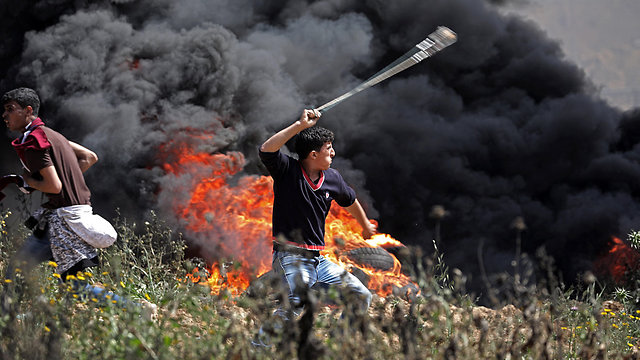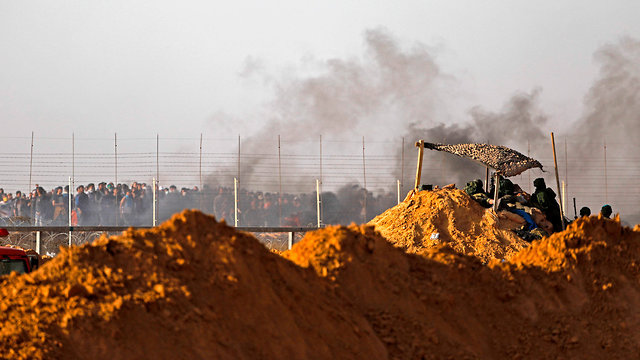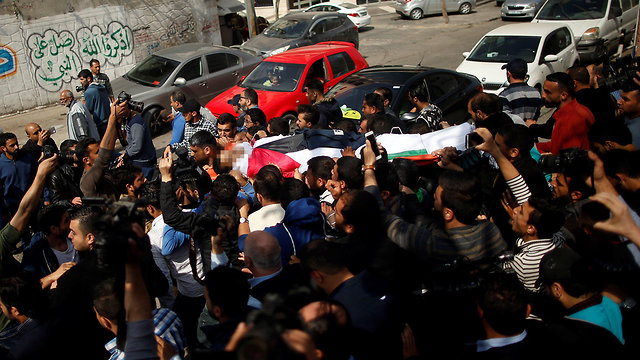

Gaza protests: When there’s smoke, there’s fire
Analysis: Most of the Palestinians killed over the weekend were hurt while running amok towards the fence, as the IDF had no other way to stop them. So far, the Israeli army has avoided targeting substantial Hamas assets deep within the strip so as not to spoil Passover—but now that the Jewish holiday is behind us, the riots’ organizers could be targeted too.
The IDF chief of staff and the four generals leading the battle on the fence—the deputy chief of staff, the head of the Operations Directorate, the Southern Command chief and the Military Intelligence Directorate chief—decided to endure the events so as not to spoil Israelis' holiday.
But now that Passover is behind us, plans aimed at breaking the status quo that has been developing between Hamas and the IDF on the Gaza border are back on the decision-makers’ table, increasing the chance that another riot on the fence would lead to an attack on tunnels or on ammunition production facilities and depots deep within the strip. It’s reasonable to assume that aerial activity isn’t the only thing on the agenda, and that a targeted assassination of the riots’ organizers is possible too.

The “entrenchment war,” in which each side entrenches itself along the border in an attempt to wear out the other side, doesn’t serve the Israeli interest, as it has the potential of creating ongoing international damage. Moreover, a series of violent clashes, week after week, will eventually lead to the eruption of a full-blown conflict, including at an unfavorable timing for Israel.
Last Friday’s violence reached its peak towards the end of the day, in what the army refers to as “the third stage of the waves of violence.”
The first stage was gathering the protestors in the morning hours and then moving towards the fence, still in a controlled manner, as Hamas members made sure to place the young men it had recruited at the front. Families and older people were left in the second line, in the back.
The second stage began by setting fire to thousands of tires. The intention was to send cells to target IDF soldiers and break into Israeli territory, using the smoke for cover. It didn’t work. The IDF curbed this wave.
The third stage included outbursts of rage in two places: In Saja’iyya, near the Karni Crossing, and at the border area in Rafah. This outburst was described by those who witnessed it as young people running amok towards the fence following the memorial ceremonies held in the area for the 23 Palestinians killed the previous week. Most of the nine Palestinians who were killed over the past weekend were likely hurt at this stage, as there was no other way to stop them.

The army understands the diplomatic, PR and operational damage caused by such a high number of casualties. The battalion commanders in charge of issuing orders to the snipers were briefed on the limitations of the rules of engagement and briefed their soldiers in detail. But it turns out that tear gas, pyrotechnics and stun grenades are inefficient when you’re dealing with people who are running amok. To stop these people from storming the fence, there is no other choice but to shoot, and people get killed.
The memorial ceremonies on the fence will fuel this week’s riots and the riots of the coming weeks, and we’ll soon find ourselves in a conflict that will only get worse.
Last Friday found both sides at a crossroads. Israel knows that the high death toll could exacerbate the violence, which is why it must prepare for the upcoming protests in a different manner by changing the orders, adding fences and perhaps making massive use of crowd dispersal means like gas grenades. On the other hand, it must try to break Hamas’ patterns of action while harming its interests.
But Hamas is at a crossroads too. The huge number of wounded Palestinians clogged Gaza’s health system. About 500 Palestinians have been wounded by shots fired at their legs. Hamas is incapable of attending to and rehabilitating such a large number of injured people. It will have to recalculate its route. The public required by Hamas to attend the protests will likely demand protection from the IDF snipers. The natural response to snipers is sniping from the other side. But once the soldiers’ lives are jeopardized, nothing will stop the IDF from launching a military operation deep within Gaza.
So far, Hamas hasn’t achieved too much. It is marking time. Gaza’s distress may be making headlines again, but the world’s attention—including the Al-Jazeera network’s—has quickly been diverted to the dozens of civilians killed in Syrian and Russian bombings on the outskirts of Damascus.
Hamas has succeeded, however, in maintaining its momentum: Some 20,000 to 25,000 people attended the past weekend’s protests. Hamas is still leading the Palestinian struggle in the face of Palestinian President Mahmoud Abbas’ impotence. It has managed to preserve the narrative of a popular struggle, and its trump card in the past weekend was the body of the Palestinian journalist killed on the fence.
The upcoming clashes this Friday will be held just before Palestinian Prisoners' Day, which is marked on April 17. We will likely see a rerun of the violent events we have seen so far, perhaps even worse than last Friday’s events. Each side learns the other side’s weak spots and pulls out new tricks, which guarantees more and more casualties.
The IDF can deploy forces along the fence for many months, but the State of Israel can’t afford to play this game for long. The problem is that there is no third party at the moment to intervene and mediate. The Americans couldn’t care less about the Gaza story. The Egyptians are making offers of mediation, but they don’t really care either. The Palestinian Authority isn’t shedding any tears. Abbas may have decided to make a gesture and suspend the sanctions against the strip, but his side is keeping quiet. He is even gloating over the trouble Hamas has gotten itself into with Israel.
Which leaves us and Hamas, and that’s a recipe that guarantees we will keep heading down a dead-end path at full-speed.
















